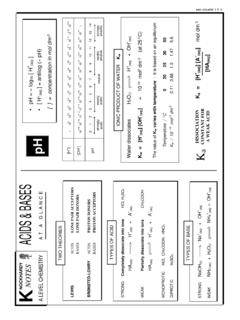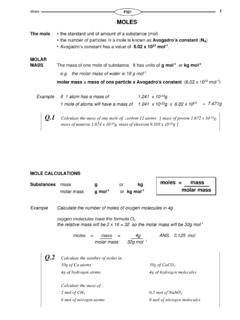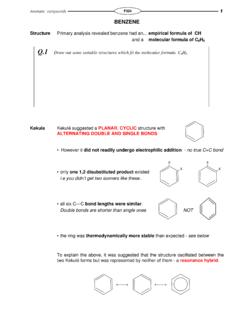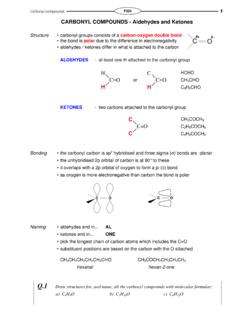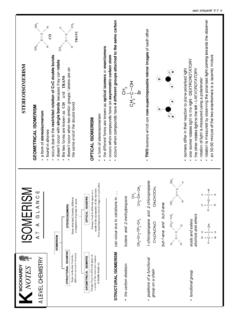Transcription of ALCOHOLS - knockhardy.org.uk
1 ALCOHOLSA liphatic general formula CnH2n+1OH - provided there are no rings named as substituted alkanes by removing the final -e and adding -ol for isomers the position of the OH is given a number - propan-1-ol / propan-2-olAromatic the OH must be attached directly to a benzene ring; known as phenols an OH on a side chain of a benzene ring behaves as a typical aliphatic ALCOHOLS are classified according to the environment of the OH functional group chemical behaviour, especially with oxidation, often depends on the structurePhysical propertiesBoiling pointIncreases with molecular size due to higher induced dipole-dipole interactions. ALCOHOLS have higher boiling points than similar molecular mass alkanes due tothe added presence of inter-molecular hydrogen bonding.
2 More energy isrequired to separate the molecules. Mr bp / CethanolC2H5OH46+78propaneC3H844-42 Boiling point also increases for straight chain branching = lower inter-molecular forces. bp / Cbutan-1-olCH3CH2CH2CH2OH 118butan-2-olCH3CH2CH(OH)CH3 1002-methylpropan-2-ol(CH3)3 COH 83 SolubilityLow molecular mass ALCOHOLS are miscible with waterdue to hydrogen bonding between the two are themselves very good solvents, being ableto dissolve a large number of organic 1 KNOCKHARDY PUBLISHING 2015 Knockhardy Publishing2 CHOHOHCH3 OHHHHCCHHCCHCCCCCC1 2 3 of the structures is/areclassified as phenols?intermolecular hydrogenbonding in alcoholsCOHCOH intermolecular hydrogenbonding with waterHOHCOHPREPARATION OF ALCOHOLSL aboratory from haloalkanes- reflux with aqueous sodium or potassium hydroxide.
3 From aldehydes - reduction with sodium tetrahydridoborate(III) - NaBH4. from alkenes- acid catalysed hydration using conc. sulphuric Reagent(s)GLUCOSE - from hydrolysis of starchConditionsyeastwarm but no higher than 37 CEquationC6H12O6 > 2 C2H5OH + 2 CO2 Direct hydrationReagent(s)ETHENE - from cracking of fractions from distilled crude oilConditions catalyst - phosphoric acid high temperature and pressureEquationC2H4 + H2O C2H5 OHFermentation advantage(s) CHEAP EQUIPMENT MADE FROM RENEWABLE RESOURCES - SUGARS disadvantage(s) SLOW REACTION IMPURE PRODUCT BATCH PROCESS - EXPENSIVE ON MANPOWERH ydration advantage(s) FAST REACTION CONTINUOUS PROCESS - CHEAPER MANPOWER PURE PRODUCT disadvantage(s)
4 MADE FROM A NON-RENEWABLE RESOURCE - OIL EXPENSIVE EQUIPMENTU sesethanol methanol fuel, added to petrol to improve combustion properties solvent a feedstock for important industrial processes2 ALCOHOLS KNOCKHARDY PUBLISHING 2015 Knockhardy some advantages and disadvantages of the two major industrial PROPERTIESG eneralLone pairs on the oxygen atom makes ALCOHOLS Lewis Bases (lone pair donors).They can use a lone pair to pick up protons behave as nucleophiles. EliminationReagentconc. sulphuric acid (H2SO4) or conc. phosphoric acid (H3PO4)Conditionsreflux 180 (l) > CH2 = CH2(g) + H2O(l)MechanismStep 1protonation of the alcohol using a lone pair on oxygenStep 2loss of a water molecule to generate a carbocationStep 3loss of a proton (H+) to give the alkeneNote 1 There must be a hydrogen atom on a carbonatom adjacent the carbon with the OH on itNote 2 ALCOHOLS with the OH in the middle of a chainhave two ways of losing water.
5 In Step 3 of themechanism, a proton can be lost from either sideof the carbocation. This can give a mixture ofalkenes from unsymmetrical alcoholsEliminationMethod 2 ConditionsPass vapour over a heated catalyst of pumice or aluminium oxide ALCOHOLS 3 KNOCKHARDY PUBLISHING 2015 Knockhardy PublishingCHHCHHHHOCHHHCHHHH reacts with concentrated sulphuric acid to give THREE isomeric are they and how are they formed?HOCCHHHHCCHHHCHHO xidation of AlcoholsProvides a way of differentiating between primary, secondary and tertiary include acidified potassium dichromate(VI) or potassium manganate(VII)PrimaryEasily oxidised to aldehydes and then to carboxylic (l) + [O] > CH3 CHO(l) + H2O(l)thenCH3 CHO(l) + [O] > CH3 COOH(l)
6 It is essential to distil off the aldehyde before it gets oxidised to the acid the alcohol is dripped into a warm solution of acidified K2Cr2O7 the aldehyde has a low boiling point - no hydrogen bonding - it distils off if it didn t distil off it would be oxidised to the equivalent carboxylic acid to oxidise an alcohol straight to the acid you would reflux the mixture compound formulaintermolecular bonding boiling point ETHANOL C2H5OH HYDROGEN BONDING 78 C ETHANAL CH3 CHO PERMANENT DIPOLE-DIPOLE 23 CETHANOIC acid CH3 COOHHYDROGEN BONDING118 CSecondaryEasily oxidised to (l) + [O] > CH3 COCH3(l) + H2O(l) prolonged treatment with a powerful oxidising agent they can be furtheroxidised to a mixture of acids with fewer carbon atoms than the original oxidised under these conditions.
7 They do break down with vigorous oxidation4 ALCOHOLS KNOCKHARDY PUBLISHING 2015 Knockhardy PublishingDISTILLATION gives anALDEHYDEREFLUXING gives aCARBOXYLIC ACIDC ombustionAlcohols make useful (l) + 3O2(g) > 2CO2(g) + 3H2O(l) have high enthalpies of combustion do not contain sulphur so there is less pollution can be obtained from renewable resourcesBrominationReagent(s)eitherconc . hydrobromic acid HBr(aq)orsodium (or potassium) bromide and conc. sulphuric acid Conditionsreflux Producthaloalkane (l) + conc. HBr(aq) > C2H5Br(l) + H2O(l)MechanismThe mechanism starts off in a similar way to the dehydration(protonation of the alcohol and loss of water) but the carbocation (carbonium ion)is attacked by a nucleophilic bromide ion in step 1protonation of the alcohol using a lone pair on oxygenStep 2loss of a water molecule to generate a carbocation (carbonium ion)Step 3a bromide ion behaves as a nucleophile and attacks the carbocationEsterification Reagent(s) carboxylic acid + strong acid catalyst ( conc.)
8 H2SO4 )Conditions reflux Product ester (l) + CH3 COOH(l) CH3 COOC2H5(l) + H2O(l) ethanolethanoic acidethyl ethanoateAn advantage of concentrated H2SO4 is that it is also a dehydrating agent andremoves water as it is formed causing the equilibrium to move to the right and thusincreasing the yield of 5 KNOCKHARDY PUBLISHING 2015 Knockhardy these esters;HCOOC2H5CH3CH2 COOCH3 Complete the equations; +HCOOC2H5 + H2 OCH3CH2CH2OH + CH3CH2 COOH +IDENTIFYING ALCOHOLS USING INFRA RED SPECTROSCOPYBONDCOMPOUND ABSORBANCERANGE O-H ALCOHOLS broad 3200 cm-1 to 3600 cm-1 O-H carboxylic acids medium to broad 2500 cm-1 to 3500 cm-1 C=O ketones, aldehydesstrong and sharp 1600 cm-1 to 1750 cm-1 esters and acidsDifferentiationCompoundO-HC=OALCOHO LYESNOALDEHYDE / KETONENOYESCARBOXYLIC ACIDYESYESESTERNOYESALCOHOLO-H absorptionALDEHYDEC=O absorptionCARBOXYLIC ACIDO-H absorptionC=O absorption6 ALCOHOLS KNOCKHARDY PUBLISHING 2015 Knockhardy PublishingFrequency , (microns) AbsorbanceFrequency , (microns)
9 AbsorbanceFrequency , (microns) AbsorbanceINDUSTRIAL PREPARATION OF ETHANOL - SUMMARYFERMENTATIONR eagent(s)GLUCOSE - from hydrolysis of starchConditionsyeastwarm but no higher than 37 CEquationC6H12O6 >2 C2H5OH + 2 CO2 LOW ENERGY PROCESS USES RENEWABLE RESOURCES - PLANTS SIMPLE EQUIPMENT SLOW PRODUCES IMPURE ETHANOL BATCH PROCESSHYDRATION OF ETHENER eagent(s)ETHENE - from cracking of fractions from distilled crude oilConditionscatalyst - phosphoric acid high temperature and pressureEquationC2H4+ H2O >C2H5OH FAST PURE ETHANOL PRODUCED CONTINUOUS PROCESS HIGH ENERGY PROCESS EXPENSIVE PLANT REQUIRED USES NON-RENEWABLE FOSSIL FUELS TO MAKE ETHENEUSES ALCOHOLIC DRINKS SOLVENT - industrial alcohol / methylated spirits (methanol is added) FUEL - used as a petrol substitute in countries with limited oil reserves KNOCKHARDY PUBLISHING 2015 Knockhardy PublishingbcBIOFUELSWhat arethey?
10 Liquid fuels made from plant material and recycled elements of the food chain biodieseldiesel alternative bioethanolpetrol additive / substituteBiodieselWhat is it?Biodiesel is an alternative fuel which can be made from waste vegetable oil orfrom oil produced from seeds. It can be used in any diesel engine, either neat ormixed with petroleum diesel. It is a green fuel, does not contribute to the carbon dioxide (CO2) burden andproduces drastically reduced engine emissions. It is non-toxic and biodegradable. Advantages renewable - derived from sugar beet, rape seed dramatically reduces emissions carbon neutral biodegradable non-toxic fuel & exhaust emissions are less unpleasant can be used directly in unmodified diesel engine high flashpoint - safer to store & transport simple to make used neat or blended in any ratio with petroleum diesel Disadvantages poor availability - very few outlets & manufacturers more expensive to produce poorly made biodiesel can cause engine problemsFuture problems there isn t enough food waste to produce large amounts of biodiesel crops grown for biodiesel use land for food crops a suitable climate is needed to grow most crops some countries have limited water resources8 ALCOHOLS KNOCKHARDY
